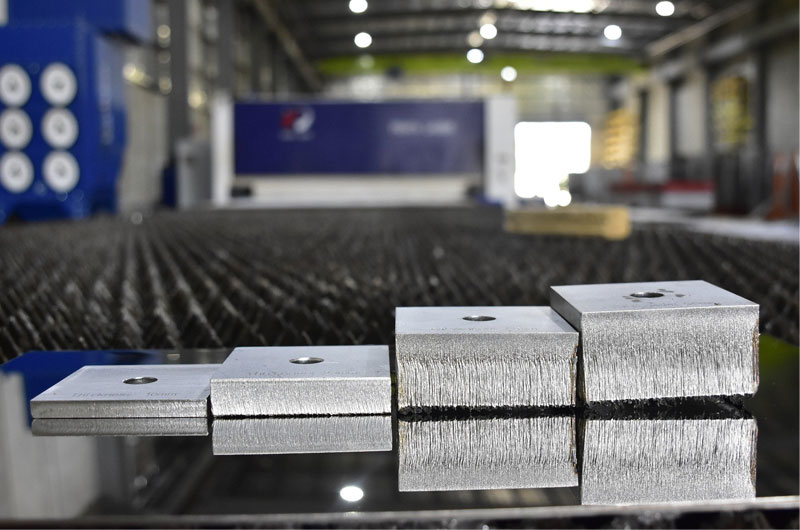One key consideration when working with stainless steel, particularly in sheet metal cutting, is how the grade affects cutting performance.
In this article, we will explore how different stainless steel grades influence cutting performance, focusing on machinability, hardness, toughness, thermal conductivity, and work hardening tendencies.
Understanding Stainless Steel Grades
Stainless steel is broadly categorized into five major families:
- Austenitic (e.g., 304, 316)
- Ferritic (e.g., 430, 409)
- Martensitic (e.g., 410, 420)
- Duplex (e.g., 2205)
- Precipitation-Hardening (PH) (e.g., 17-4PH)
Each grade has a different chemical composition and crystalline structure that influence its mechanical properties and, consequently, its behavior during cutting.
Key Material Properties Affecting Cutting Performance
1. Hardness and Strength
Harder grades, like martensitic stainless steels, tend to wear down tools faster and require more powerful cutting machines. For example, 440C is a high-carbon martensitic stainless steel known for its exceptional wear resistance, but it can be challenging to cut without the right tooling and effective cooling methods.
In contrast, austenitic grades like 304 and 316 are relatively softer but exhibit work hardening during cutting. While not as hard initially, they can become very difficult to machine as they strain harden quickly, increasing tool wear and requiring frequent tool changes or regrinding.
2. Toughness
Toughness impacts how a material reacts to cutting forces. A high-toughness material may absorb more energy and resist cracking, which is useful for impact resistance but makes precision cutting harder. Duplex stainless steels, known for their excellent toughness and strength, pose cutting challenges due to their dual-phase microstructure that resists deformation and increases tool loading.
3. Thermal Conductivity
Compared to carbon steel, stainless steel exhibits lower thermal conductivity. This means that heat generated during cutting doesn’t dissipate quickly, especially with austenitic and duplex grades. Heat accumulation can cause tool overheating, edge wear, and workpiece distortion. Efficient cooling and tool materials with good heat resistance become essential.
4. Work Hardening Tendency
Austenitic grades like 304 and 316 are well known for their tendency to work-harden quickly during machining. As the cutting tool progresses through the material, the stainless steel hardens, increasing resistance to further cutting. This can lead to higher power consumption, more heat, and rapid tool degradation.
Martensitic and ferritic grades typically exhibit lower work hardening tendencies, making them slightly easier to cut in continuous operations.
Cutting Techniques and Stainless Steel Grades
Different cutting methods—such as laser cutting, plasma cutting, waterjet cutting, and mechanical methods like shearing or sawing—interact differently with various stainless steel grades. Understanding the behavior of each grade can help optimize the cutting process.
1. Laser Cutting
Laser cutting offers high precision and is commonly used for thinner stainless steel sheets. However, grades like 304 and 316 can reflect laser beams and require careful adjustment of laser parameters. Additionally, the work hardening tendency of 304 may create burrs if the cutting speed or focus isn’t properly calibrated. Duplex and martensitic grades often need higher laser power due to their higher strength.
2. Waterjet Cutting
Waterjet cutting doesn’t generate heat, making it suitable for heat-sensitive grades like 316 and duplex stainless steels. Since it avoids work hardening and heat-affected zones (HAZ), it is often preferred for thicker sheets or when edge quality is critical.
3. Plasma Cutting
Plasma cutting is effective for thicker sections but less precise than laser or waterjet. It may leave a wider kerf and more dross on high-alloy grades. Grades with high chromium content may react with plasma gases, affecting edge finish.
4. Mechanical Cutting (Shearing, Sawing, Milling)
Mechanical cutting methods struggle with work-hardened surfaces. Austenitic grades require sharp tools and slower speeds. For ferritic and martensitic steels, standard high-speed tools can be used, although harder grades might need carbide-tipped blades.
Grade-by-Grade Cutting Performance Overview
Here’s a breakdown of how common stainless steel grades affect cutting:
- 304 (Austenitic): Most widely used stainless steel. Excellent corrosion resistance but tough to cut due to work hardening. Requires slower speeds and robust tooling.
- 316 (Austenitic): Similar to 304 but with molybdenum for enhanced corrosion resistance. Has even higher work hardening rates and is more difficult to cut cleanly.
- 430 (Ferritic): Magnetic and less corrosion-resistant than austenitic grades. Easier to cut with mechanical methods but more prone to distortion.
- 410 (Martensitic): Harder and more brittle. Requires preheating and specialized tools, but easier to cut cleanly in thin sections.
- 2205 (Duplex): High strength and toughness make this grade challenging to cut. Requires powerful equipment and aggressive cooling strategies.
- 17-4 PH (Precipitation-Hardening): Very hard and strong after heat treatment. Needs high-performance cutting tools and often preheating for thicker sections.
Best Practices for Cutting Stainless Steel by Grade
To optimize cutting performance across grades:
- Use the Right Tools: Carbide or ceramic-coated tools are recommended for hard and work-hardening grades.
- Adjust Cutting Speeds: Slower speeds and higher feed rates help minimize heat and prevent excessive work hardening.
- Apply Coolant Liberally: Especially important for grades with low thermal conductivity like 304 and duplex stainless steels.
- Avoid Interruptions: Continuous cutting reduces the onset of work hardening.
- Use Grade-Specific Parameters: Cutting conditions must be adapted based on the specific properties of each grade.

